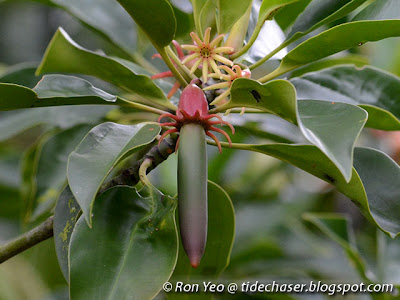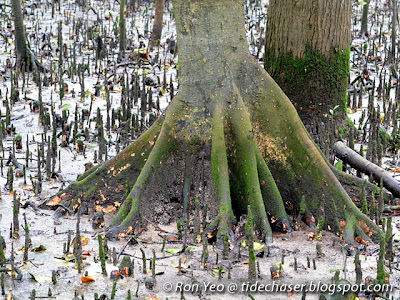The Berus Mata Buaya (Bruguiera hainesii) is a nationally and internationally critically endangered mangrove tree from the family Rhizophoraceae.
Personally, I only know of 2 trees on Pulau Ubin, 1 at Pasir Ris and 1 at Kranji. It was previously seen in the western catchment, and may possibly be found still there, and I have previously also seen 1 propagule on Pulau Tekong, but did not see any existing tree.
Mature plants may have buttress roots at the base of the trunk. The roots radiating from the tree somewhat loop above and below ground, forming knee roots. These roots help the plant breathe air, which is scarce in the waterlogged soil. The roots spread over a wide area to help stabilise the tree on the unstable ground. Like other mangrove species from the family Rhizophoraceae, B. hainesii relies on its roots to exclude salt from entering the plant through a process called ultrafiltration.
The trunk is dark grey or brown in colour with numerous lenticels for gas exchange.
It has simple, opposite leaves that are elliptic with pointed tips, clustering towards the end of the branch.
The flowers are white or light orange, and the petal lobes have 2-4 bristles at the tip, while the calyx (with 10 lobes) ranges from whitish, light green/orange (shady conditions) to red (sunny conditions).
The petals turn brown quickly.
Vivipary is observed in this plant, as with the other mangrove species from the family Rhizophoraceae. This is a condition whereby the embryo grows and break through the seed coat and the fruit wall while still attached to the parent plant. Hence, the long structures seen hanging from the trees are seedlings, not fruits. The calyx lobes extend away from the seedling and bend downwards perpendicularly, and the seedling itself is cylindrical and sometimes curved.
The seedling is dispersed by water. It floats horizontally for a few weeks, during which the root (lower part) will absorb water and become heavier, eventually causing the seedling to tip and float vertically. As the tide goes down, the vertically-oriented seedling will sink into the mud or other suitable substrates. Most of the seedlings, however, end up being washed ashore or eaten by animals.
The wood is used for firewood and construction.
References
- Chong, K. Y., H. T. W. Tan & R. T. Corlett, 2009. A Checklist of the Total Vascular Plant Flora of Singapore: Native, Naturalised and Cultivated Species. Raffles Museum of Biodiversity Research, National University of Singapore. Singapore. 273 pp.
- Giesen, W., S. Wulffraat, M. Zieren & L. Scholten. 2006. Mangrove guidebook for Southeast Asia. RAP Publication 2006/07. FAO Regional Office for Asia and the Pacific & Wetlands International. Bangkok. 769 pp.

No comments:
Post a Comment